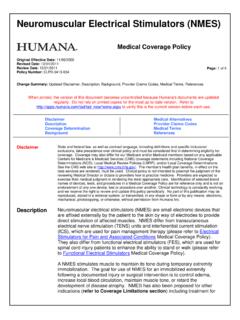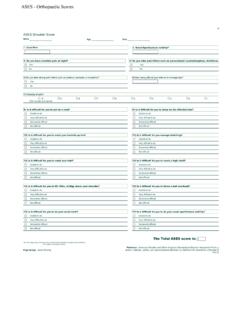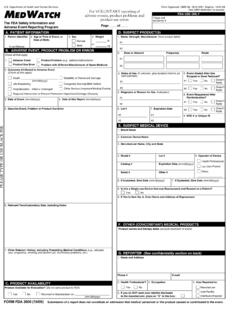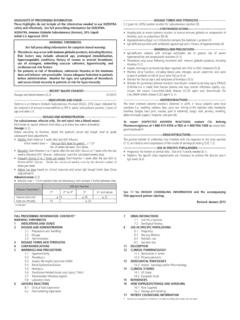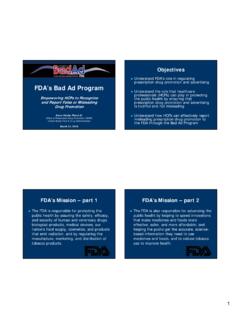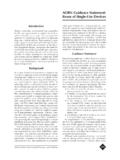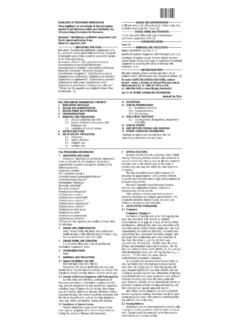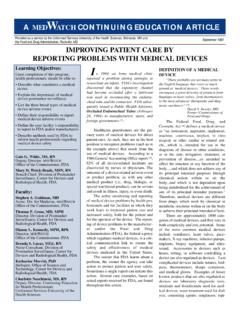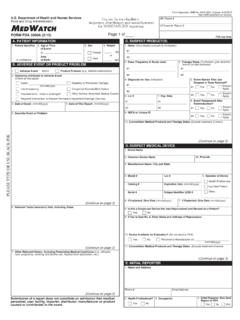Transcription of ADVERSE EVENT REPORTING – AN FDA …
1 ADVERSE EVENT REPORTING AN FDA REQUIREMENTWHAT, WHEN, WHO & HOWAMERICAN ACADEMY OF ORTHOPAEDIC SURGEONS75TH ANNUAL MEETINGMARCH 5 - 9, 2008 SAN FRANCISCO, CALIFORNIACOMMITTEE ON BIOMEDICAL ENGINEERINGPREPARED BY:JOHN S. KIRKPATRICK, SETH GREENWALD, (OXON)MICHAEL E. BEREND, A. BROWN, , MCGOWAN, MIHALKO, , orthopaedic surgeons in the course of their practice will encounter and explant medical devices which have failed. Such failures may simply result from long-term in-vivo device usage, component material breakdown, technique at the time of implantation or patient noncompliance.
2 Changes in the Safe Medical Devices Act of 1990 (SMDA), a Law enacted by the Congress, requires that medical device user facilities inclusive of hospitals, ambulatory surgical facilities and nursing homes report such events to the Food and Drug Administration (FDA) and manufacturers. These events are inclusive of device problems which cause or contribute to the death, serious illness or serious injury of a patient. The orthopaedic surgeon is involved in the identifi cation and interpretation of these problems.
3 In June 1993, the FDA introduced medwatch , a medical products REPORTING program, to facilitate the REPORTING of ADVERSE events and product problems that arise from medical device usage. What is an ADVERSE EVENT ?An EVENT whereby a death or serious injury was, or may have been caused by a medical device. Serious injury can be interpreted to mean requiring medical or surgical management to preclude impairment or damage to the body s function or structure with removal, observation, medical treatment, or hospitalization.
4 This includes events resulting from:- Device malfunction - Improper / inadequate design - Labeling (problems)- Device failure - Manufacturing (problems) - Use error When should an ADVERSE EVENT be reported by an orthopaedic surgeon? ADVERSE events should be reported once the individual patient s safety is ensured. While hospitals and manufacturers have mandatory REPORTING , surgeons have no such requirement. Unfortunately, those best able to provide clinical context are removed from the process. Surgeon REPORTING of any and all device failures and ADVERSE events will bring relevance to the report and improve the safety decisions made by the FDA.
5 Who should report events ? Surgeons provide the most relevant and useful information and provide insight into the cause and effect of the EVENT . Perhaps the most important role is to differentiate whether the device failed or the disease process or patient biological issues caused the problem. Surgeons may participate in their facilities mandatory annual REPORTING process. Manufacturers are required to fi le ADVERSE events . Surgeons may also fi le voluntary reports individually. How should an ADVERSE EVENT be reported?
6 The surgeon can go to This web page has the instructions and the link to beginning the forms. Part 5 is the most important for surgeons to provide an interpretation of the EVENT . Examples will include answers to Part 5 for the cases in this exhibit. What about HIPPAA?The [HIPAA] Privacy Rule permits covered entities to disclose protected health information, without authorization, to public health authorities who are legally authorized to receive such reports for the purpose of presenting or controlling disease, injury, or disability.
7 This would include, for example, the REPORTING of a disease or injury; REPORTING vital events , such as births or deaths; and conducting health surveillance, investigations, or interventions. A public health authority is an agency or authority of the United States government, a State, a territory, a political subdivision of a State or territory, or Indian tribe that is responsible for public health matters as part of its offi cial mandate, as well as a person or entity acting under a grant of authority from, or under a contract with, a public health agency.
8 Examples of a public health authority include a State and local health departments, the Food and Drug Administration (FDA), the Centers for Disease Control and Prevention, and the Occupational Safety and Health Administration (OSHA). The following examples illustrate these 1A 50-year-old obese female with multiple sclerosis had multiple failed thoracolumbar spinal fusions for low back pain. One of the fusion attempts had been complicated by a MRSA infection. She developed junctional kyphosis and neurological defi cit superior to her construct and had evidence of pseudarthrosis also.
9 She had decompression and re-fusion with replacement of her prior hardware and extension superiorly. Approximately 18 months later she presented with pain and crepitus in her low back and radiographs showed fracture of her rods bilaterally. She requested removal of her hardware and attempted fusion of her persistent pseudarthrosis. Was this a failure of the hardware? Technically yes, but this must be qualifi ed by the failure of the patient s biology to heal her fusion while the hardware was in PART 5 Patient had fusion with posterior fi xation for failed prior fusion with a MRSA infection.
10 The rods were noted to be broken and the patient had pain and crepitus from the broken rods rubbing together. Patient had removal and re-fusion of the non-union 18 months following implantation. In light of the patient s clinical setting this was interpreted as a failure of the patient s biology, not a failure of the device. CASE 2 This patient had a sudden onset of pain and diffi culty ambulating 21 months after bilateral primary total knee arthroplasty surgery. He had no signs of infection and only had diffi culty with his right knee.



